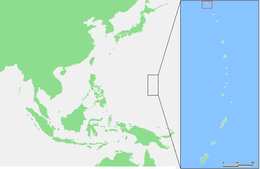Farallon de Pajaros

view of Farallón de Pájaros
|
|
| Geography | |
|---|---|
| Location | Pacific Ocean |
| Coordinates | 20°32′42″N 144°53′37″E / 20.54500°N 144.89361°E |
| Archipelago | Mariana Islands |
| Area | 2.3 km2 (0.89 sq mi) |
| Length | 1.8 km (1.12 mi) |
| Width | 1.6 km (0.99 mi) |
| Highest elevation | 360 m (1,180 ft) |
| Highest point | Farallon de Pajaros |
| Administration | |
|
United States
|
|
| Commonwealth | Northern Mariana Islands |
| Demographics | |
| Population | - uninhabited - (2010) |
Farallón de Pájaros (from Spanish Farallón de los pájaros, meaning "Birds' Rock"), also known as Urracas (from Spanish Urracas, meaning "Magpies"), is a small (2.3 km2) uninhabited volcanic island, the northernmost island in the Northern Mariana Islands chain.
Farallón de Pájaros is the northernmost island of the Marianas chain. It is located 65 kilometers (40 mi) northwest of the Maug Islands and 591 km (367 mi) north of Saipan, the main island of the Northern Mariana Islands. Its northern neighbor is South Iwo Jima of the Ogasawara Islands of Japan, located 541 km (336 mi) away.
Farallón de Pájaros is nearly circular, with a length of 1.8 km (1.1 mi), a width of 1.6 km (0.99 mi) and has an area of 2.3 km2 (0.89 sq mi). Farallón de Pájaros is the top of an active stratovolcano with a height of 360 meters (1,180 ft) above sea level. The base of this stratovolcano is about 2,000 feet (610 m) below sea level, it has a diameter of 15 to 20 kilometers. Between 1864 and 1953, 15 volcanic eruptions have been recorded.
In the area of Farallón de Pájaros are two submarine volcanoes: The Makhahnas Seamount located about 10 km (6.2 mi) southwest, reaching a height of 640 m (2,100 ft) below sea level, and last erupted in 1967. The Ahyi Seamount located about 18 km (11 mi) south-east and reached a height of 137 m (449 ft) below sea level. It is associated with a possible eruption in 1979, and an eruption in 2001.
Presumably Farallon de Pajaros was never permanently inhabited.
From 1899 to 1914, Farallón de Pájaros was controlled by the German Empire and was administered as part of the colony of German New Guinea. In 1903 the island was leased to a Japanese company, which hunted birds whose feathers exported to Japan and then to Paris.
...
Wikipedia

